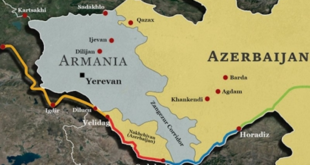In most discussions of the Qarabagh dispute, few pay much attention to Armenian exclaves in Azerbaijani territory and Azerbaijani exclaves in Armenian territory, but the status of those will have to be addressed for any delimitation of the Armenian-Azerbaijani border to take place, Geydar Isayev says.
The Baku journalist says these enclaves are of two kinds, districts the Soviets set up as part of one republic and populated by the ethnicity of the other and entirely surrounded by its territory, and villages with Armenian populations in the past near but not in Qarabagh and whose former residents want that to be reflected in any settlement (russian.eurasianet.org/армения-азербайджан-судьба-эксклавов-остается-нерешенной).
The Azerbaijani advance recovered what have become known as “the seven villages:” Baganis Ayrum, Nizhnaya Askipara, Kheirimli and Gizilhajili on the Azerbaijani side of the Soviet border but which had been controlled by Armenia and populated by Armenians since the early 1990s, Isayev says.
Four other villages north of Qarabagh, Verkhnaya Askipara, Sofulu, and Barkhudarly, were recognized by the Soviets as Azerbaijani enclaves within Armenia, populated by ethnic Azerbaijanis until the early 1990s and governed from the Azerbaijani side of the borders. Toi the south of Qarabagh is another Azerbaijani exclave, the historically Azerbaijani village of Karki, that the Nakhichevan Autonomous Republic of Azerbaijan until Armenia drove out the population and governing institutions.
None of these eight places is large in terms either of area or population, and some of them are in fact ghost towns in which almost no one lives. But they are important to the people who were driven from them and who hope that as part of a settlement, they will be able to return to what they see as their rightful homes, attitudes neither Baku nor Yerevan can ignore.
To date, however, Isayev continues, “the central organs of executive power in Baku and Yerevan have kept relatively silent about the fate of the exclaves,” although in May an Armenian opposition leader said he had evidence that the Armenian government planned ot hand them over to Azerbaijan.
That would compromise Yerevan in the eyes of its population and also create problems in the future because the villages in the north are on the route of the main road between Yerevan and Tbilisi, a highway that is the primary route for supplies coming into Armenia from the Russian Federation.
After that report, Armenian Prime Minister Nikol Pashinyan said that he would “prefer to exchange the exclaves and not take under control land within the borders of another country.” But Baku officials want to restore Azerbaijani control of these villages because that would give Baku a strategic military advantage.
Officials at the Azerbaijani Committee on Refugee Affairs say that Baku wants to see all those forced to leave “the seven villages” settled on territories that Azerbaijan has restored its control of rather than insisting on their return to the places of their former residence (youtube.com/watch?v=c3KW81myM4U&t=1s).
On both sides, there is some flexibility, but it is not infinite and officials in Baku and Yerevan can ignore the attitudes of those who were forced out and now want to return only at their peril since, if either capital caves on what these refugees see as a question of principle, that will affect not only their attitudes but those of all the refugees and indeed the populations of both countries.
 Eurasia Press & News
Eurasia Press & News



